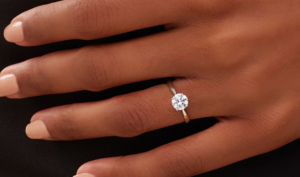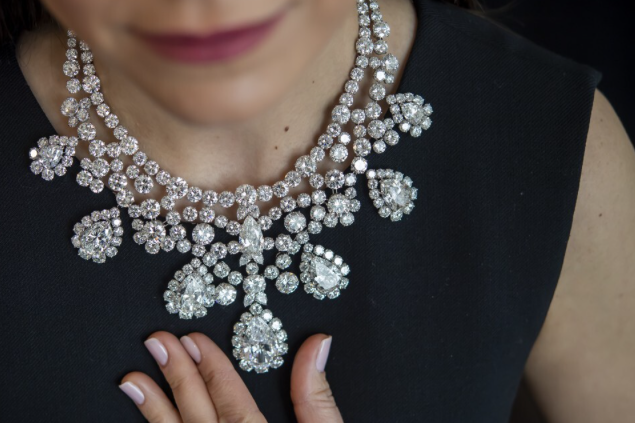Instead, as a “testament to our ongoing and ambitious sustainability agenda”, Pandora would use only diamonds grown in laboratories”, Pandora CEO Alexander Lacik said in May, announcing the Pandora Brilliance range featuring lab-grown diamonds set in rings, bangles, necklaces and earrings.
Not so fast, responded a diamond industry group a few days later, objecting to a “false and misleading narrative” in the Pandora announcement.

Delicacy ring, the most popular engagement ring at 77 Diamonds, Europe’s largest online diamond jeweller.
The Natural Diamond Council (NDC), the World Jewellery Confederation (CIBJO), the World Diamond Council (WDC) and the Responsible Jewellery Council (IJC) jointly said the diamond industry employs tens of millions of people around the world and many communities in developing nations rely on income and welfare from diamond mining.
Pandora, the group added in the statement, should retract its claim that lab-grown diamonds were an ethical choice compared with naturally-mined diamonds. The announcement, the group added, could “have unintended but substantial consequences”.
Diamond mining has been regarded as a dubious enterprise for years, with films including the 2006 drama Blood Diamond starring Leonardo di Caprio built on the idea that the stone that graces a woman’s neck or wrist could be splattered with the gore of human rights abuse.
Yet Tobias Kormind, co-founder of Europe’s largest online diamond retailer, 77 Diamonds, says these days the diamond mining industry has largely eliminated shady dealings with potential war lords. Many mobile telephones, he adds, include rare earth metals that are more likely to be connected to human rights abuse than nearly any diamonds.
“I’m not saying the diamond industry doesn’t have any issues,” he says. “It’s working on traceability, so you have the journey of every single diamond. The industry is dominated by a few large miners who have a really transparent supply chain.”
Diamonds retain a mystical appeal. The hardest substance in the world, natural diamonds were formed deep in the Earth’s mantle billions of years ago. Diamonds are one of the world’s most portable forms of wealth, and maybe the most popular precious stone.
The 77 Diamonds company now sells both naturally-mined and lab-grown diamonds produced in the US, China, Europe and India. Originally produced for the vast industrial diamond market, and first made in sufficient sizes for jewellery about a decade ago, lab-grown stones are now roughly one-third the price of the mined variety, with prices falling as production techniques are perfected.
“The time it takes to grow a diamond in a lab has come down, it depends on the size of the stone, but it’s weeks, no more than that,” Kormind says. “Lab-grown diamonds are declining in value year on year. In a few years time I see it moving out of the luxury category into more of a premium category.”
According to a diamond industry report by Bain, six to seven million carats of lab-grown diamonds were produced in 2020 and 111 million carats of diamond came from mines, Kormind adds. “The proportion of lab-grown diamonds is increasing year on year,” he adds, noting that detecting the difference between the two types of stone is almost impossible without sophisticated equipment.
Although some in the industry think younger jewellery buyers are turning to lab-grown diamonds because they are seen as the more ethical choice, Komind believes a lot of the momentum is driven by economics. “Because the price is coming down, that’s very attractive to people who want the size and don’t want to pay the money,” he says. “They can easily back-solve into ethical arguments about it.”
Meanwhile, Kormind adds, growing the stones in laboratories uses a vast amount of energy and 60 per cent of the world’s lab-grown diamonds are now produced in China. “So what are the labour practices in the factories there?”
Some customers are more interested in the size of the stones than the question of whether they were produced in a lab or mined from the Earth’s crust. “I’m dealing with a customer who wants to upgrade from a two carat naturally-mined diamond to a six carat lab-grown,” he says. “It will cost her a tiny bit more.”
His 77 Diamonds company has an on-line selection system that allows customers to specify the size, colour, cut and quality of a diamond, and then learn the price (of a stone either mined or lab-grown).
For instance, a round one carat diamond, with IF (internally flawless) clarity, colour D (colourless), mined in Botswana, could cost 8,625.94 British pounds or HK$94,683.28, according to the 77 Diamonds website. This compares with the price of an extremely similar, also round, one carat lab-grown diamond, with IF clarity, colour D, and otherwise almost identical specifications to the mined stone, which could cost 3,222.69 British pounds or HK$35,383.33.
The jewellery giant Pandora’s decision not to use mined diamonds comes a year after the company announced it would no longer use newly mined gold and silver in its jewellery. By 2025, the company plans to only use recycled metals in its jewellery – part of the policy to ensure its operations are carbon neutral within four years. Pandora has said the lab-grown diamonds it uses are produced with an average of more than 60 per cent renewable energy, a ratio set to rise to 100 per cent in 2022 when the Pandora Brilliance lab-grown diamond jewellery range is launched globally.
Kormind says the retailer’s strategy is admirable. “Pandora, because the price of lab-grown diamonds has come down so far, they are now coming out with a whole lab-grown range, which for me is a real sign of a coming of age for the lab-grown industry,” he says. Lab-grown diamonds will boost the accessibility of diamonds in fashion jewellery, he adds, and they could be seen as an introduction to the world of diamonds, a step toward eventually owning the more expensive naturally-mined stones which will always be more valuable.
“Diamonds are too expensive to use in their jewellery,” Kormind says. “They’ve been waiting for lab-growns to come down in price. Lab-growns are now low enough, keep within price points their customers expect. That’s what it’s about really. They’ve made it an ethical thing and I don’t want to detract from what they’re doing.
“I think they are trying to reach out to consumers and play the sustainability piece. It’s genuine, but I don’t think they’re only doing it for economic reasons. I think they are genuinely, as a company, trying to move in a more sustainable way. It’s a double win. Had it only been sustainability, they wouldn’t have done it; there had to be a compelling economic argument as well.”
https://www.scmp.com/lifestyle/fashion-beauty/article/3134438/pandora-says-lab-grown-diamonds-ethical-choice-not-so-say?module=lead_hero_story_7&pgtype=homepage

